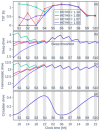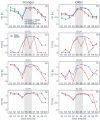Impact of Varying Sleep Pressure on Daytime Sleep Propensity in Healthy Young and Older Adults
- PMID: 39846530
- PMCID: PMC11755553
- DOI: 10.3390/clockssleep7010002
Impact of Varying Sleep Pressure on Daytime Sleep Propensity in Healthy Young and Older Adults
Abstract
Fixed sleep schedules with an 8 h time in bed (TIB) are used to ensure participants are well-rested before laboratory studies. However, such schedules may lead to cumulative excess wakefulness in young individuals. Effects on older individuals are unknown. We combine modelling and experimental data to quantify the effects of sleep debt on sleep propensity in healthy younger and older participants. A model of arousal dynamics was fitted to sleep data from 22 young (20-31 y.o.) and 26 older (61-82 y.o.) individuals (25 male) undertaking 10 short sleep-wake cycles during a 40 h napping protocol, following >1 week of fixed 8 h TIB schedules. Homeostatic sleep drive at the study start was varied systematically to identify best fits between observed and predicted sleep profiles for individuals and group averages. Daytime sleep duration was the same on the two days of the protocol within the groups but different between the groups (young: 3.14 ± 0.98 h vs. 3.06 ± 0.75 h, older: 2.60 ± 0.98 h vs. 2.37 ± 0.64 h). The model predicted an initial homeostatic drive of 11.2 ± 3.5% (young) and 10.1 ± 3.5% (older) above well-rested. Individual variability in first-day, but not second-day, sleep patterns was explained by the differences in the initial homeostatic drive for both age groups. Our study suggests that both younger and older participants arrive at the laboratory with cumulative sleep debt, despite 8 h TiB schedules, which dissipates after the first four sleep opportunities on the protocol. This has implications for protocol design and the interpretation of laboratory studies.
Keywords: ageing; homeostatic pressure; modelling; napping; sleep; sleep debt; sleep propensity.
Conflict of interest statement
This was not an industry-supported study. The authors of this work declare that there are no conflicts of interest related to this study. While CB is the founder and CEO of PHYSIP SA, no compensation was given to Physip for this research, and Physip did not provide any funding for this research.
Figures





Similar articles
-
The effect of split sleep schedules (6h-on/6h-off) on neurobehavioural performance, sleep and sleepiness.Appl Ergon. 2016 May;54:72-82. doi: 10.1016/j.apergo.2015.12.004. Epub 2015 Dec 21. Appl Ergon. 2016. PMID: 26851466
-
Staying vigilant during recurrent sleep restriction: dose-response effects of time-in-bed and benefits of daytime napping.Sleep. 2022 Apr 11;45(4):zsac023. doi: 10.1093/sleep/zsac023. Sleep. 2022. PMID: 35089345 Free PMC article.
-
Sleep restriction masks the influence of the circadian process on sleep propensity.Chronobiol Int. 2012 Jun;29(5):565-71. doi: 10.3109/07420528.2012.675256. Chronobiol Int. 2012. PMID: 22621352
-
Novel Augmentation Strategies in Major Depression.Dan Med J. 2017 Apr;64(4):B5338. Dan Med J. 2017. PMID: 28385173 Review.
-
Benefits of napping in healthy adults: impact of nap length, time of day, age, and experience with napping.J Sleep Res. 2009 Jun;18(2):272-81. doi: 10.1111/j.1365-2869.2008.00718.x. J Sleep Res. 2009. PMID: 19645971 Review.
References
-
- Borbely A.A. A Two Process Model of Sleep Regulation. Hum. Neurobiol. 1982;1:195–204. - PubMed
-
- Borbély A.A., Achermann P. Chapter 33—Sleep Homeostasis and Models of Sleep Regulation. In: Kryger M.H., Roth T., Dement W.C., editors. Principles and Practice of Sleep Medicine (Fourth Edition) W.B. Saunders; Philadelphia, PA, USA: 2005. pp. 405–417.
Grants and funding
LinkOut - more resources
Full Text Sources

